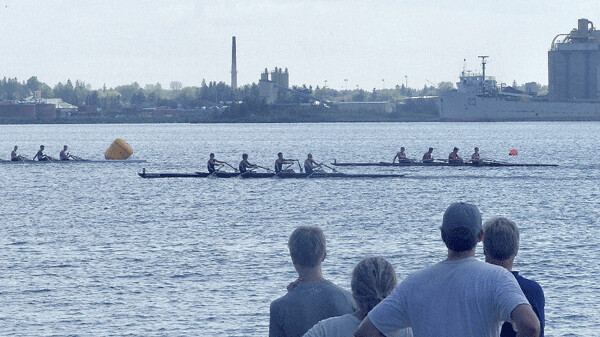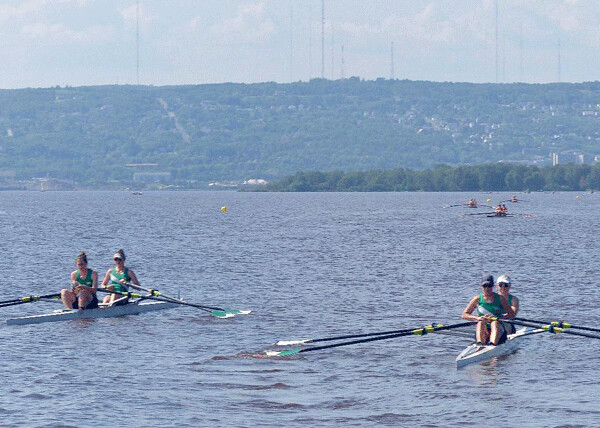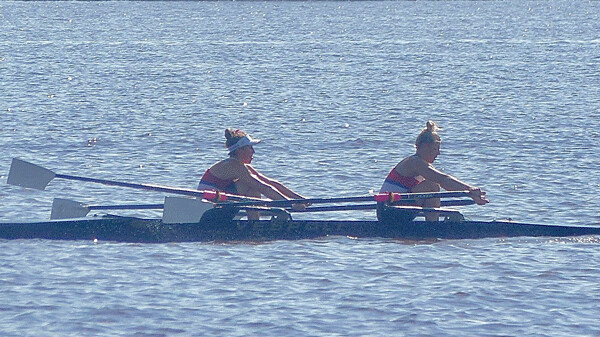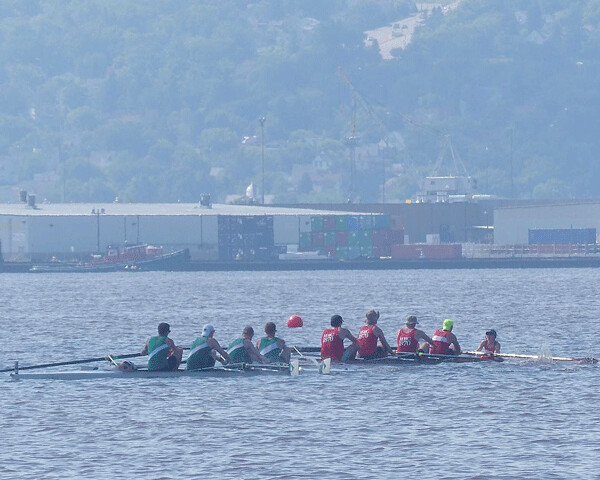Rowing returns to bay for Duluth Regatta




Summertime in the Northland is always a treat, especially afer the long-awaited actual summer weather hit us in the past week. Among the nuggets out there on All-Star week in both the Major and Northwoods Leagues, easily overlooked, and as an exclamation point to all those kayakers who can be seen virtually every day on the North Shore, was the Duluth Rowing Club regatta on Park Point.
Somewhere over 300 rowers prove the healthy rejuvenation of a sport that used to be popular in the first half of the 20th century, but had seemingly become visible only if you were in Boston, near Harvard, and could walk over to the Charles River to see these long, sleek water-skimmers zoom along with practiced efficiency.
Maybe it’s all that kayak rowing, but the sport of rowing is making a serious comeback. At the 60th annual Duluth rowing regatta, there were classes for every age, male and female, in singles, twos, fours, and eights, and in age classes that included Junior, for age 13-18, Open for age 19-26, and Masters, for 27 and over.
For me, it was just an enjoyable way to spend a couple of hours on a day when the temperature soared to a Duluth-tropic high-80s. Operating on the bay side, right at the newly built rowing facilities, the competitors from the Upper Midwest, and Canada, would launch themselves into their shells and skim away, gliding across the fairly smooth surface. They’d “warm up” by rowing themselves up the shoreline, maybe a half-mile or mile, then on their group’s turn, they’d race back to the finish line, near where they started out. The trick in rowing is to get everybody coordinated, so that their oars make the least splash as they bite into the water’s surface, and that whether two, four or six oar-folks are in the shell, they row with a coordinated smoothness.
Looks easy, but isn’t. Much practice is required to get them coordinated, and once there, the rhythm is more important than the power needed to keep rowing.
The rejuvenated Duluth Rowing Club won four firsts during the long Saturday on the bay, claiming Junior Men 8s, Masters Men 4, Masters Men double, and Masters Women;s 4. There was tremendous competition between Minneapolis and Minnesota clubs, with Minneapolis taking eight firsts, and Minnesota taking six, and Thunder Bay, Rochester, and Kenora also proving good enough to win their share.
But the biggest winner? Long Lake, which captures nine first places in men’s and women’s competition.
In soccer, they have nonleague matches called “Friendlies,” and in rowing, the sportsmanship and competition is evident in every heat. Everyone strives to win, but everybody also is giving everything on every event, so nobody feels too bad when they fail to win.
Twins ‘Battle’ their way to 9-2 surge to All-Star
No, the Twins didn’t get Eddie Rosario onto the All-Star team. Maybe Minnesota is too smalltown to generate enough fan votes. But it doesn’t matter, because maybe he needs a few days rest, instead. Jose Berrios was the only Twins player to make the American League roster, and with all the arms on that staff, they really didn’t need him, either.
It was a fun show, as All-Star games often are. But we also have to look back to a strong ending to the first half by the Twins, who won 9 of their last 11 games up to the break for Tuesday night’s game in Washington, D.C. Consider the final first-half game.
The Twins beat Baltimore 11-7 when Brian Dozier hit a grand slam in the 10th inning, but the real fun was in the seventh, when the Twins rallied to tie the game 7-7 with a four-run rally. Dozier had contributed, driving in a run, and ending up on third after an intentional walk and an infield single loaded the bases.
The Orioles deployed in a shift favored by the new computerized way of the game, meaning three infielders were on the first-base side, and the other was about at shortstop. That meant nobody was at third, so Dozier went into a neat routine, sprinting a few steps up the baseline, as if to steal home, and knowing pitcher Diego Castillo couldn’t throw to third, with nobody covering. Dozier’s sprint start was good enough that Castillo flinched — balk!
That meant Dozier could skip home, exulting as he did, with the tying run. Castillo was irked, and the poor batter was Eduardo Escobar, who had been hit by a pitch in the previous inning. Castillo fired a 101-mph fastball at Escobar’s knees. He bailed, and picked himself up, now agitated himself. He struck out, but exchanged hostilities with Castillo after the pitch. The two had to be separated by teammates, and both sides sent all the teammates they had, in their dugouts and in their bullpens.
It was a bench-clearing brawl, only it wasn’t much of a brawl because nobody threw a punch. Order seemed to be restored, but as the changeover for the inning ensued, players in each dugout chirped away, and the bench-clearing hassle reoccured. Again, nobody threw a punch, and the score stayed 7-7 until the 10th, when Dozier socked his game-winning home run.
Signs of life from the Twins, from the pitching staff, and from Dozier, and the Twins are set up to entertain us for the second half of the season.
